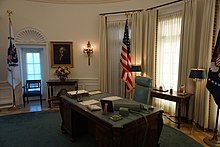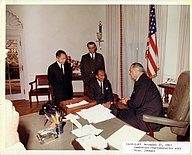Johnson desk
 Lady Bird Johnson listening to President Lyndon B. Johnson, at the desk, on the phone upon Robert Kennedy's death. | |
| Designer | Thomas D. Wadelton |
|---|---|
| Date | 1909 |
| Made in | Chicago, Illinois |
| Materials | Mahogany, leather |
| Height | 30.25 in (76.8 cm) |
| Width | 75.5 in (192 cm) |
| Depth | 42.5 in (108 cm) |
| Collection | United States Senate |
The Johnson desk is a mahogany partners desk that was used by U.S. President Lyndon B. Johnson in the Oval Office as his Oval Office desk. One of only six desks used by a president in the Oval Office, it was designed by Thomas D. Wadelton and built in 1909 by S. Karpen and Bros. in Chicago. The desk was built as part of 125 seven-piece office sets for senators' offices in the Russell Senate Office Building, and was used by Johnson during his terms as U.S. Senator, Vice President, and President. It is currently located at Lyndon Baines Johnson Library and Museum as part of a replica Oval Office.
Design and markings[]
The Johnson Desk is a mahogany partners desk. Built in 1909, the designs of the front and the back of the desk are mirrors of each other. Each face of the two pedestal desk has three drawers on one pedestal and a hinged-door cabinet on the other. The desk has four writing slides, two on each side, and each pedestal sits on four bun feet. Mahogany veneer covers the desk's top and sides as well as the drawer and cabinet fronts. A central foot stretcher was originally upholstered with leather. Each of the four corners of the desk is built with a rectangular, outset, console bracket with a stylized flower blossom carved into each side. The desk is 30.25 in (76.8 cm) tall with a work surface measuring 75.5 in (192 cm) wide and 42.5 in (108 cm) deep.[1] There is a manufacturer's tag on the interior of both top-right drawers which reads "GEO. W. COBB JR. / COMMERCIAL FURNITURE / NEW YORK, N.Y."[1]
The desk was designed as part of a seven-piece office furniture set for rooms in the Russell Senate Office Building. Hastings, one of the architects of the building, said the furniture pieces were designed to be "very American" in style, and inspiration for the design was drawn from "old books of the furniture of our forefathers".[2] After inspecting models of the furniture designs, Hastings said, "So far as I am capable of judging, I think it is going to be the swellest set of furniture of the time that I have ever seen. It is the real thing, and has all the character and dignity which it seems to me furniture for the United States senators should have".[2] He also commented on the "rich brown color" achieved on the furniture pieces as well as the "effects obtained by matching the veneers".[2]
When in the Oval Office, Lyndon B. Johnson used a modified green vinyl helicopter seat, complete with built-in ashtray, as the chair at this desk.[3] A day after moving into the office, a matching green top was added to the desk, replacing a standard desk blotter.[4][5]
History[]

The Johnson desk was one of 125 identical desks designed by Thomas D. Wadelton, a New York cabinetmaker, and built by S. Karpen and Bros. in Chicago under contract with George W. Cobb, Jr., for the Russell Senate Office Building.[1] Opened on March 5, 1909, the Russell Building was designed by Carrère & Hastings and was created to alleviate overcrowding in the Capitol building. The new structure provided 98 new suites, 10 individual rooms, and 8 committee rooms for Senate offices.[1][2]
Each desk cost $80.00 (equivalent to $2,304 in 2020) and was part of a set of standard furniture for each Senator's office.[1] According to the Senate, besides the desk this set included "a swivel desk chair, a round arm chair, a square arm chair, a small side chair, an easy chair, and a davenport".[1] Ninety-two sets of furniture were created for the opening of the Russell Building, one set for each of the Senators from the then 46 states, with additional sets ordered after the building opened.[2] The building was expanded in 1933 and six additional desks were manufactured for the new rooms.[1] The furniture for the Russell Building was the largest single furniture contract issued by the Senate. Many of the pieces continue to be used in Senate offices to this day.[2]
In 1948, Lyndon B. Johnson was narrowly elected to the Senate and quickly moved up the ranks becoming Democratic whip in 1951, Democratic leader in 1953, and Senate majority leader in 1955.[6] Over this quick succession of positions, Johnson continually worked out of Room 231 in the Russell Senate Office Building, then simply known as the Senate Office Building.[7][8][9][10]
After becoming majority leader, Johnson appropriated a room on the third floor of the Capitol Building as the majority leader's working office. This space, being one floor above the Senate Chamber, turned out to be inconvenient for Johnson. In 1958, a new office building was built to house Senate committees, freeing up highly sought-after space in the Capitol building.[11] In 1959, Johnson moved his majority leader's office to Rooms S-211 and S-212, which were originally designed for the Senate Library but used for the Senate District of Columbia Committee instead.[11][12] Johnson was particularly fond of Room S-211 where he placed his desk, and which was later renamed "The Lyndon Baines Johnson Room".[12] Johnson had the room refurbished in vibrant colors and it picked up the nickname "Taj Mahal".[11] Johnson continued to use these rooms even after becoming Vice President in 1961, forcing the then majority leader, Mike Mansfield, to open a new office across the hall.[11] Johnson stopped using these rooms only once he ascended to the office of President.[12]
After President John F. Kennedy's assassination, Johnson did not move into the Oval Office for several days, possibly at the request of Robert Kennedy.[13] He finally did begin using the room on November 26, 1963.[14] When he entered the Oval Office, a series of changes were made to the room that were planned by Jacqueline Kennedy, but not completed until that point due to updates to an air-conditioning system, including a new red rug and white drapes. Johnson had the Resolute desk, the desk Kennedy used in the office, removed and replaced with the desk that he had used throughout his time in the Senate and as Vice President.[14][15] The Resolute desk went on tour around the country at this time to help raise funds for the John F. Kennedy Presidential Library and Museum and was subsequently put on view at the Smithsonian Institution.[16]
Johnson called Gordon Bunshaft, the architect for the forthcoming Johnson Library and Museum, on October 10, 1968, to discuss the presidential library he was designing and his desire to have the Johnson desk moved to it. He stated, "I hate to build me a little one out there at the side and say, this is the way the President's office looked. And here's his desk and here's his chair. Here's his FDR picture... maybe we don't have to have the same height ceiling... and maybe we can't have the same oval room... But it seems to me that if we could, we ought to take this rug out of here and this—just as the Kennedys are doing and have done, just as the Trumans did—and ought to take the desk and ought to take the chairs..."[17]
The Johnson desk was moved to the Lyndon Baines Johnson Library and Museum in Austin, Texas, and sits in the 7/8-scale replica Oval Office there. Johnson was known to sit at the desk on occasion to surprise visitors.[18][15]
References[]
- ^ Jump up to: a b c d e f g "Desk, Flat-Top Partner". United States Senate. Archived from the original on November 27, 2020. Retrieved November 30, 2020.
- ^ Jump up to: a b c d e f Russell Senate Office Building: furniture. U.S. Senate Commission on Art by the Office of Senate Curator. Senate Publication 110–26. Retrieved November 30, 2020.
- ^ Saffo, Paul (June 11, 2008). "Obama's 'Cybergenic' Edge" (opinion). ABC News. Archived from the original on November 6, 2018. Retrieved December 1, 2020.
- ^ Enlargement, Nov. 26, 1963, 1963-11-26-CA10-1. Archived May 16, 2016, at the Wayback Machine. White House Photo Office. Lyndon B. Johnson Presidential Library. Retrieved December 2, 2020.
- ^ Enlargement, Nov. 27, 1963, 1963-11-27-CA18-1. Archived April 2, 2016, at the Wayback Machine. White House Photo Office. Lyndon B. Johnson Presidential Library.
- ^ "Lyndon B. Johnson: A Featured Biography". United States Senate. Archived from the original on November 26, 2020. Retrieved December 1, 2020.
- ^ Official congressional directory. 81st congress 1st session 1949. United States Government printing Office. 1949. p. 299. Retrieved December 1, 2020.
- ^ Official Congressional Directory. United States Congress. 1951. p. 325. retrieved December 1, 2020.
- ^ Official Congressional Directory. United States Congress.1953. p. 340. Retrieved December 1, 2020.
- ^ Official congressional directory. 84th congress lst session. United States Government printing Office. 1955. p. 344. Retrieved December 1, 2020.
- ^ Jump up to: a b c d "The Senate's Taj Mahal". United States Senate. Archived from the original on October 10, 2020. Retrieved December 1, 2020.
- ^ Jump up to: a b c The Lyndon Baines Johnson Room. Office of Senate Curator. Senate Publication 105–60. Retrieved December 1, 2020.
- ^ Ball, Moya Ann (Winter 1994). "The Phantom of the Oval Office: The John F. Kennedy Assassination's Symbolic Impact on Lyndon B. Johnson, His Key Advisers, and the Vietnam Decision-Making Process". Presidential Studies Quarterly. 24 (1): 105–119. JSTOR 27551197.
- ^ Jump up to: a b "Johnson Moves Into White House's Oval Office; Also Installs Own Rocker, Pictures and Desk as Red Carpet Is Rolled Out". The New York Times. November 27, 1963. p. 16. Retrieved December 12, 2020. ProQuest URL
- ^ Jump up to: a b Artifacts in the Oval Office. Lyndon Baines Johnson Library and Museum. Retrieved December 1, 2020.
- ^ Historic Desk Loaned to President Carter. Smithsonian Institution. 1977. Retrieved December 1, 2020.
- ^ A Conversation between LBJ and Gordon Bunshaft. Lyndon Baines Johnson Library and Museum. November 10, 1968 8:57 p.m. Retrieved November 30, 2020.
- ^ Hess, Stephen (January 8, 2009). "What Now? The Oval Office". Brookings Institution. Archived from the original on August 3, 2020. Retrieved November 30, 2020.
External links[]
| Wikimedia Commons has media related to Johnson desk. |
- Presidency of Lyndon B. Johnson
- Furnishings of the White House
- Individual desks



